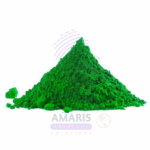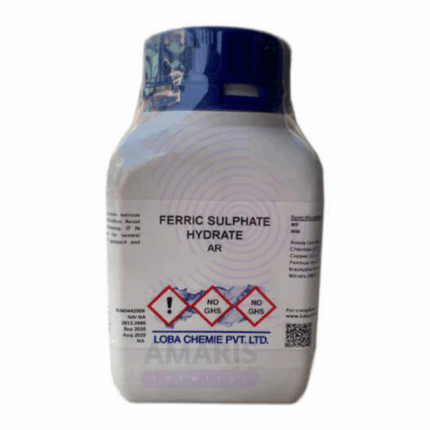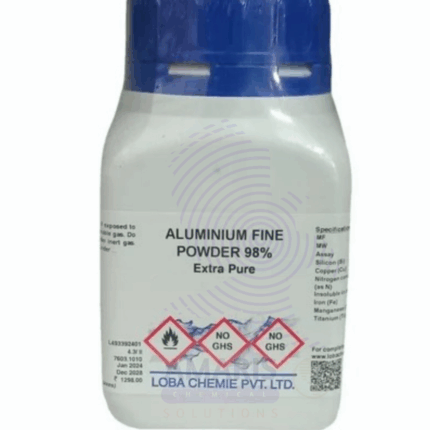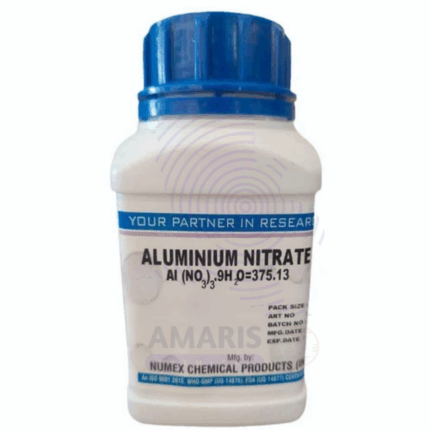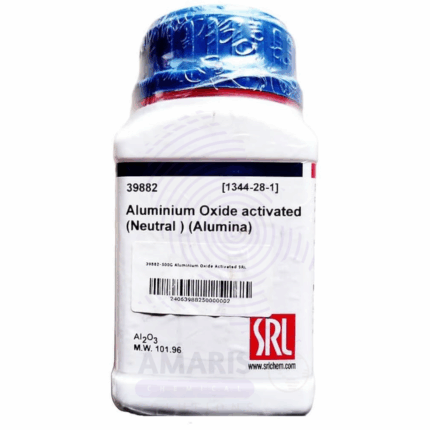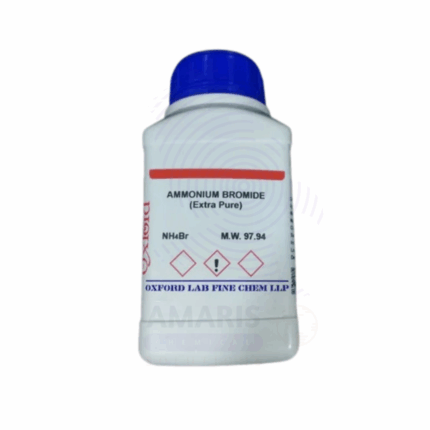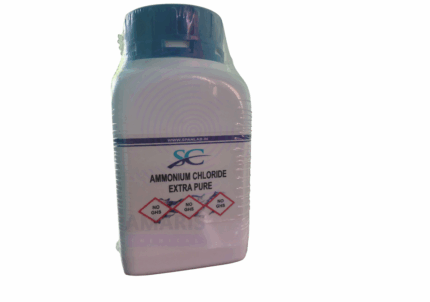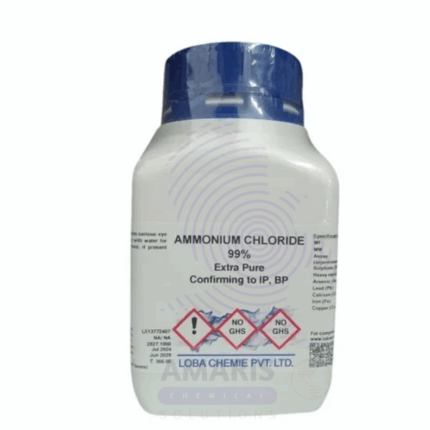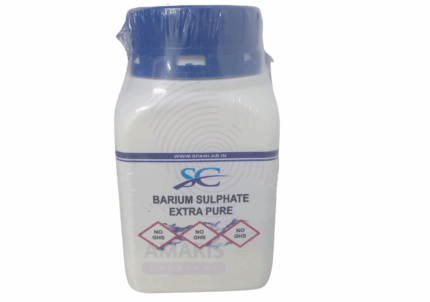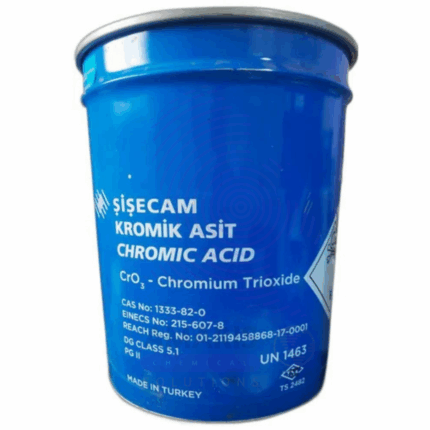
Anhydrous Barium Chloride Extra Pure
$ 19.00 Original price was: $ 19.00.$ 18.67Current price is: $ 18.67.
Anhydrous Barium Chloride Extra Pure is a high-purity, white crystalline compound widely used in laboratory chemistry for analytical, inorganic, and materials science applications. It serves as a key reagent for the qualitative and quantitative determination of sulfate ions, forming an insoluble barium sulfate precipitate in gravimetric analysis. Additionally, it is employed in the synthesis of other barium compounds, in flame tests for barium detection, and in studies involving ionic conductivity and salt solubility. The anhydrous form is especially useful in moisture-sensitive reactions and precise stoichiometric formulations. Its extra pure grade ensures minimal contamination, making it ideal for high-accuracy research. It should be handled with care and stored in tightly sealed containers in a dry, cool environment to prevent hydration and preserve reactivity.
Anhydrous Barium Chloride Extra Pure
Primary Uses
- Reagent for Sulfate Ion Detection
- Reacts with SO₄²⁻ to form insoluble barium sulfate (BaSO₄) — a classical test for the qualitative and gravimetric analysis of sulfate ions.
- Source of Barium Ions in Inorganic Chemistry
- Supplies Ba²⁺ for precipitation reactions, double salt formation, and study of ionic equilibria.
- Precursor for Synthesis of Other Barium Salts
- Used to prepare barium nitrate, barium carbonate, or barium titanate in lab-scale material synthesis.
- Demonstration of Flame Tests and Spectroscopy
- Produces a green flame in flame tests, useful in qualitative spectroscopy and elemental identification exercises.
- Component in High-Purity Chemical Reactions
- Used when moisture must be excluded (e.g., non-aqueous syntheses) or where anhydrous conditions are critical.
Secondary Uses
- Reagent in Water Hardness and Ion Exchange Studies
- Useful in exploring water treatment chemistry, especially regarding removal or identification of sulfate and carbonate hardness.
- Crystal Growth and Solid-State Chemistry
- Involved in growing single crystals for X-ray diffraction or structure–property studies in barium-containing compounds.
- Component in Conductivity and Solubility Experiments
- Employed in solution conductivity experiments to demonstrate ionic mobility and solubility differences.
- Investigation of Precipitation Kinetics and Equilibria
- A model salt for studying solubility product (Ksp) and reaction dynamics of sparingly soluble salts.
- Teaching Reagent for Group II Cation Identification
- Helps distinguish Group II metal ions (e.g., Ca²⁺, Sr²⁺, Ba²⁺) based on precipitation and flame color.
| PACK SIZE |
500 grams Plastic Tin |
|---|
1. Basic Identification Attributes
- Chemical Name: Barium Chloride (Anhydrous)
- CAS Number: 10361-37-2
- HS Code: 28273990 (Barium chloride, other than hydrated or analytical grade)
- Molecular Formula: BaCl₂
- Synonyms:
- Barium dichloride
- Barium(II) chloride
- Chlorobarium
- Anhydrous BaCl₂
2. Physical & Chemical Properties
- Physical State: Solid (crystalline powder)
- Color & Odor: White crystals; odorless
- Boiling Point: ~1560 °C
- Melting Point: ~962 °C
- Density/Specific Gravity: ~3.86 g/cm³
- Solubility:
- Water: Soluble (~37 g/100 mL at 20 °C)
- Alcohol: Insoluble
- pH Level: ~6–8 (in aqueous solution)
- Vapor Pressure: Negligible
- Flash Point: Not flammable
- Autoignition Temperature: Not applicable
- Viscosity: Not applicable
3. Safety & Hazard Attributes
- Hazard Class (GHS):
- Acute Toxicity – Oral (Category 3)
- Serious Eye Irritation (Category 2A)
- Specific Target Organ Toxicity – Single Exposure (Category 1: cardiovascular and muscular systems)
- NFPA Ratings:
- Health: 3
- Flammability: 0
- Reactivity: 0
- Exposure Limits:
- ACGIH TLV (for soluble barium salts): 0.5 mg/m³ (as Ba)
- Reactivity:
- Stable under normal conditions
- Incompatible with strong acids (releases toxic HCl and barium ions)
4. Storage & Handling Attributes
- Storage Conditions:
- Store in a dry, cool, well-ventilated area
- Hygroscopic – keep container tightly closed
- Incompatible Materials:
- Acids, sulfates, and oxidizing agents
- Container Type:
- Sealed plastic or glass containers
- Shelf Life & Expiration Date:
- ~3 years if kept dry and sealed
- Special Handling Requirements:
- Use gloves, goggles, and lab coat
- Prevent dust inhalation and ingestion
- Use a fume hood if handling powders
5. Regulatory & Compliance Attributes
- Regulatory Status:
- Listed in TSCA, REACH
- Toxic substance – regulated under workplace safety laws
- Transportation Restrictions:
- Not classified as hazardous for transport in small lab quantities
- Waste Disposal Method:
- Dispose as hazardous waste
- Avoid contact with drains due to barium ion toxicity
6. Environmental & Health Impact
- Ecotoxicity:
- Very toxic to aquatic life (especially due to barium ions)
- Persistence in Environment:
- Inorganic; does not degrade but can accumulate
- Carcinogenicity/Mutagenicity:
- Not classified as carcinogenic
- Biodegradability:
- Not biodegradable
SAFETY PRECAUTIONS
- Personal Protective Equipment (PPE):
- Wear a lab coat, chemical splash goggles, and chemical-resistant gloves (nitrile recommended).
- Use in a fume hood or well-ventilated area to avoid inhaling dust.
- Handling:
- Avoid inhalation, ingestion, and contact with skin or eyes.
- Handle with care to minimize dust generation—dust is toxic.
- Keep away from acids (may form toxic hydrogen chloride gas) and moisture (hygroscopic).
- Storage:
- Store in a tightly sealed container in a cool, dry, well-ventilated place.
- Keep away from acids, moisture, and oxidizing agents.
- Label clearly as Toxic and Harmful if swallowed.
- Hygiene Measures:
- Wash hands and face thoroughly after handling.
- Avoid cross-contamination with food, drinks, or cosmetics.
- Clean all work surfaces after use.
FIRST AID MEASURES
- Inhalation:
- Move the person to fresh air immediately.
- If breathing is difficult, give oxygen and seek immediate medical attention.
- Inhalation of dust may cause respiratory irritation or systemic toxicity.
- Skin Contact:
- Wash the affected area thoroughly with soap and water.
- Remove contaminated clothing.
- Seek medical attention if irritation develops.
- Eye Contact:
- Rinse eyes immediately with plenty of water for at least 15 minutes.
- Hold eyelids open and remove contact lenses if present.
- Seek immediate medical attention—can cause eye irritation or burns.
- Ingestion:
- Do NOT induce vomiting.
- Rinse mouth with water.
- If the person is conscious, give water or milk to dilute.
- Seek immediate medical attention—barium compounds are highly toxic and may cause:
- Muscle weakness
- Arrhythmias
- Gastrointestinal pain
- Hypokalemia
FIRE FIGHTING MEASURES
- Suitable Extinguishing Media:
- Use dry chemical, carbon dioxide (CO₂), or appropriate foam.
- Water spray may be used only for cooling—not on the chemical directly.
- Specific Hazards:
- Not flammable, but may decompose on heating, releasing:
- Chloride vapors
- Barium oxides (toxic dust)
- Not flammable, but may decompose on heating, releasing:
- Protective Equipment for Firefighters:
- Wear self-contained breathing apparatus (SCBA) and full protective gear.
- Firefighting Instructions:
- Prevent spread of dust or contamination of water supplies.
- Avoid runoff—barium salts are toxic to aquatic life and soil.


 Preservatives(food)
Preservatives(food) Flavor Enhancers
Flavor Enhancers Acidulants
Acidulants Sweeteners
Sweeteners Antioxidants
Antioxidants Colorants(food)
Colorants(food) Nutraceutical Ingredients (food)
Nutraceutical Ingredients (food) Nutrient Supplements
Nutrient Supplements Emulsifiers
Emulsifiers
 Collectors
Collectors Dust Suppressants
Dust Suppressants Explosives and Blasting Agents
Explosives and Blasting Agents Flocculants and Coagulants
Flocculants and Coagulants Frothers
Frothers Leaching Agents
Leaching Agents pH Modifiers
pH Modifiers Precious Metal Extraction Agents
Precious Metal Extraction Agents
 Antioxidants(plastic)
Antioxidants(plastic) Colorants (Pigments, Dyes)
Colorants (Pigments, Dyes) Fillers and Reinforcements
Fillers and Reinforcements Flame Retardants
Flame Retardants Monomers
Monomers Plasticizers
Plasticizers Polymerization Initiators
Polymerization Initiators Stabilizers (UV, Heat)
Stabilizers (UV, Heat)
 Antifoaming Agents
Antifoaming Agents Chelating Agents
Chelating Agents Coagulants and Flocculants
Coagulants and Flocculants Corrosion Inhibitors
Corrosion Inhibitors Disinfectants and Biocides
Disinfectants and Biocides Oxidizing Agents
Oxidizing Agents pH Adjusters
pH Adjusters Scale Inhibitors( water)
Scale Inhibitors( water)
 Antioxidants(cosmetic)
Antioxidants(cosmetic) Emollients
Emollients Fragrances and Essential Oils
Fragrances and Essential Oils Humectants
Humectants Preservatives
Preservatives Surfactants(cosmetic)
Surfactants(cosmetic) Thickeners
Thickeners UV Filters
UV Filters
 Fertilizers
Fertilizers Soil Conditioners
Soil Conditioners Plant Growth Regulators
Plant Growth Regulators Animal Feed Additives
Animal Feed Additives Biostimulants
Biostimulants Pesticides (Herbicides, Insecticides, Fungicides)
Pesticides (Herbicides, Insecticides, Fungicides)
 Active Pharmaceutical Ingredients (APIs)
Active Pharmaceutical Ingredients (APIs) Excipients
Excipients Solvents(pharmaceutical)
Solvents(pharmaceutical) Antibiotics
Antibiotics Antiseptics and Disinfectants
Antiseptics and Disinfectants Vaccine Adjuvants
Vaccine Adjuvants Nutraceutical Ingredients (pharmaceutical)
Nutraceutical Ingredients (pharmaceutical) Analgesics & Antipyretics
Analgesics & Antipyretics
 Analytical Reagents
Analytical Reagents Solvents(lab)
Solvents(lab) Chromatography Chemicals
Chromatography Chemicals Spectroscopy Reagents
Spectroscopy Reagents microbiology-and-cell-culture-reagents
microbiology-and-cell-culture-reagents Molecular Biology Reagents
Molecular Biology Reagents Biochemical Reagents
Biochemical Reagents Inorganic and Organic Standards
Inorganic and Organic Standards Laboratory Safety Chemicals
Laboratory Safety Chemicals Specialty Laboratory Chemicals(Special Laboratory Equipment)
Specialty Laboratory Chemicals(Special Laboratory Equipment)
 Demulsifiers
Demulsifiers Hydraulic Fracturing Fluids
Hydraulic Fracturing Fluids Scale Inhibitors(oil)
Scale Inhibitors(oil) Surfactants(oil)
Surfactants(oil) Drilling Fluids
Drilling Fluids
 Dyes and Pigments
Dyes and Pigments Bleaching Agents
Bleaching Agents Softening Agents
Softening Agents Finishing Agents
Finishing Agents Antistatic Agents
Antistatic Agents
 Admixtures
Admixtures Waterproofing Agents
Waterproofing Agents Sealants and Adhesives
Sealants and Adhesives Curing Compounds
Curing Compounds Concrete Repair Chemicals
Concrete Repair Chemicals Anti-Corrosion Coatings
Anti-Corrosion Coatings
 Surfactants(cleaning)
Surfactants(cleaning) Builders
Builders Enzymes
Enzymes Solvents (Cleaning)
Solvents (Cleaning) Fragrances
Fragrances
 Electronic Chemicals
Electronic Chemicals Catalysts
Catalysts Lubricants
Lubricants Photographic Chemicals
Photographic Chemicals Refrigerants
Refrigerants Automotive chemicals
Automotive chemicals Pyrotechnic Chemicals
Pyrotechnic Chemicals
 Biodegradable Surfactants
Biodegradable Surfactants Bio-based Solvents
Bio-based Solvents Renewable Polymers
Renewable Polymers Carbon Capture Chemicals
Carbon Capture Chemicals Wastewater Treatment Chemicals
Wastewater Treatment Chemicals
 Pigments
Pigments Solvents(paint)
Solvents(paint) Specialty Coatings
Specialty Coatings Binders/Resins
Binders/Resins Additives
Additives Driers
Driers Anti-Corrosion Agents
Anti-Corrosion Agents Functional Coatings
Functional Coatings Application-Specific Coatings
Application-Specific Coatings
 Fresh Herbs
Fresh Herbs Ground Spices
Ground Spices Whole Spices
Whole Spices Spice Blends
Spice Blends Dried Herbs
Dried Herbs
 Leavening Agents
Leavening Agents Dough Conditioners
Dough Conditioners Flour Treatments
Flour Treatments Fat Replacers
Fat Replacers Decoratives
Decoratives Preservatives(baking)
Preservatives(baking)
 Plasticizers & Softeners
Plasticizers & Softeners Reinforcing Agents
Reinforcing Agents Adhesion Promoters
Adhesion Promoters Vulcanizing Agents
Vulcanizing Agents Antidegradants
Antidegradants Blowing Agents
Blowing Agents Fillers & Extenders
Fillers & Extenders Accelerators & Retarders
Accelerators & Retarders
